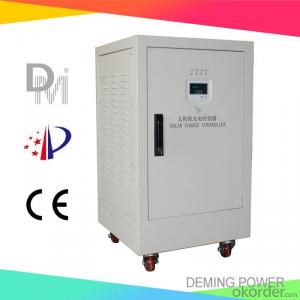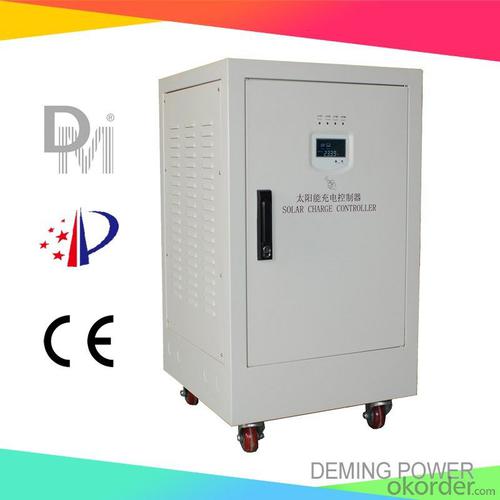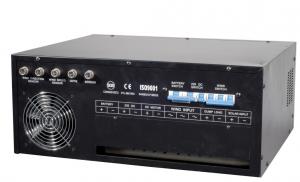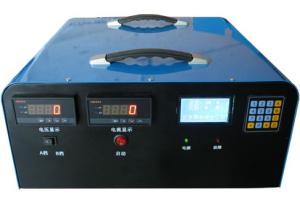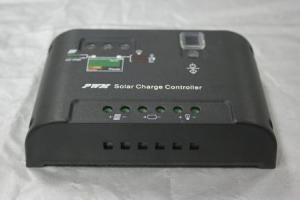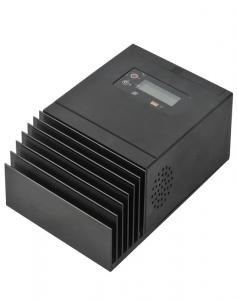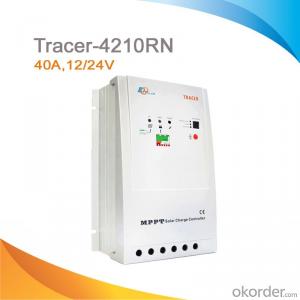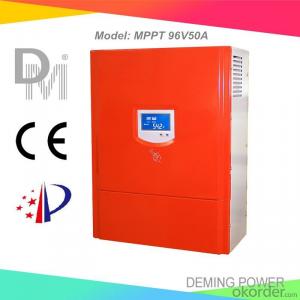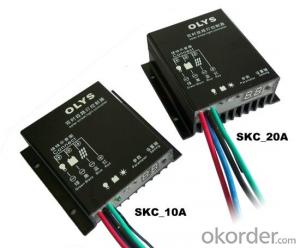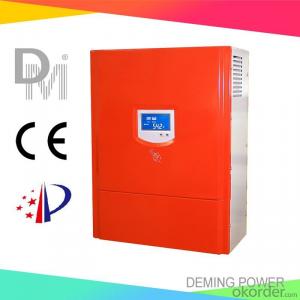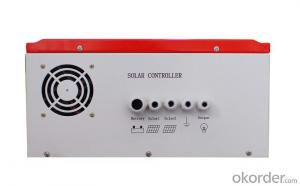Victron Solar Controllers MPPT Solar Charge Controller 96V 200A for Solar Power System
- Loading Port:
- Qingdao
- Payment Terms:
- TT OR LC
- Min Order Qty:
- 1 PCS
- Supply Capability:
- 500 PCS/month
OKorder Service Pledge
OKorder Financial Service
You Might Also Like
Properties of the solar charge controller
1. Design for off-grid solar power system.
2. Applicable to different kinds of batteries.
3. Adopts MPPT technology (Maximum Power Point Tracking). The advanced tracking algorithm make the solar module operate at ideal voltage which the solar modules can produce the maximum available power.
4. Modular design with simple structure and easy maintenance.
5. Automatic power control function.
6. LCD display: Solar panel current, solar panel voltage, solar panel power, battery group voltage, charge current.
7. Perfect protection function: Solar reverse charge protection, Solar reverse connection protection, Battery reverse connection protection, Battery overcharge protection, Battery over current protection etc ,thus the system has higher reliability.
Technical parameters of the solar charge controller
Model | 96V200A | |||||
Battery group rated voltage | 96Vdc | |||||
PV Rated current | 200A | |||||
PV open circuit voltage | 400V | |||||
PV Max. power | 19200Wp | |||||
Input PV module road number | 1 | |||||
Function | MPPT charge mode, auto stop charge, auto recharge voltage; Protection: connecting contrary, over current, short circuit, over heat etc. | |||||
Display mode | LCD | |||||
Display content | solar panel voltage, solar panel current, solar panel power, battery voltage, charge current | |||||
MPPT DC voltage range | 80-116Vdc | |||||
Floating Charge Voltage (adjustable) | 110Vdc | |||||
Stop charge voltage | 116Vdc±1% | |||||
Recharge voltage | 108V±1% | |||||
Voltage drop between PV and battery | 1.5V | |||||
Max itself power consumption | 100mA-150mA | |||||
Work environment temperature | -30-60°C | |||||
Relative humidity | 90% No condensation | |||||
Applicable altitude | 3000m The rated power should be reduced when it is higher than 2000m | |||||
Noise (1m) | 40dB | |||||
Degree of protection | IP20(Indoor) | |||||
Cooling method | Forced air cooling | |||||
*Communication interface (optional) | RS485/USB/GPRS/Ethernet | |||||
*Temperature compensation(optional) | -4mv/°C/2V,-35°C~+80°C,Accuracy:±1°C | |||||
Product size (mm) | 900*500*500mm | |||||
Product Weight(kg) | 50kg | |||||
*Above parameter only for reference. Could be custom made to user specifications.
- Q: What is the purpose of the battery voltage regulation feature on a solar controller?
- The purpose of the battery voltage regulation feature on a solar controller is to ensure that the batteries connected to the solar system are charged and maintained at the optimal voltage level. This feature controls the charging process to prevent overcharging, which can damage the batteries, and also prevents the batteries from being discharged too much, which can reduce their lifespan. By regulating the voltage, the solar controller helps to maximize the efficiency and longevity of the battery bank in a solar power system.
- Q: Can a solar controller be used with a solar-powered RV?
- Yes, a solar controller can be used with a solar-powered RV. In fact, it is highly recommended to use a solar controller to regulate the charging and discharging of the RV's batteries. The solar controller helps optimize the charging process, prevents overcharging, and extends the lifespan of the batteries.
- Q: What is the role of a battery low voltage disconnect function in a solar controller?
- The role of a battery low voltage disconnect function in a solar controller is to protect the battery from being over-discharged. It automatically cuts off the power supply from the solar panels to the battery when the battery voltage drops below a certain threshold. This helps extend the battery's lifespan and ensures that there is always enough charge left for essential loads.
- Q: What is the purpose of the battery state of charge display feature on a solar controller?
- The purpose of the battery state of charge display feature on a solar controller is to provide the user with real-time information about the amount of charge remaining in the battery. This feature allows the user to monitor the battery's state of charge and make informed decisions about how to manage their energy usage. By displaying the battery state of charge, the solar controller helps the user optimize their energy consumption and avoid depleting the battery completely. It allows them to track the battery's capacity and plan their energy usage accordingly, ensuring that they always have enough power available. Furthermore, the battery state of charge display feature also helps in prolonging the battery's lifespan. Overcharging or deep discharging a battery can significantly reduce its capacity and overall lifespan. With this feature, users can easily monitor the battery's state of charge and avoid these detrimental practices, thereby increasing the longevity of the battery. In summary, the battery state of charge display feature on a solar controller serves the purpose of providing users with valuable information about the battery's charge level. It enables them to optimize their energy usage, avoid depleting the battery completely, and prolong its lifespan.
- Q: Can a solar controller be used with a solar-powered chicken coop?
- Yes, a solar controller can be used with a solar-powered chicken coop. A solar controller is responsible for regulating the flow of electricity from the solar panels to the batteries, preventing overcharging and optimizing the system's performance. It ensures that the batteries are charged properly and efficiently. In a solar-powered chicken coop, a solar controller would be essential to manage the power generated by the solar panels and ensure reliable energy supply for lighting, ventilation, and any other electrical needs of the coop.
- Q: What is the role of a load control function in a solar controller?
- The role of a load control function in a solar controller is to regulate and manage the power output of the solar panels, ensuring that the energy generated is efficiently utilized and distributed to the connected loads. It helps prevent overcharging of batteries and protects the system from damage due to overvoltage or overcurrent conditions. Additionally, the load control function can prioritize and schedule power supply to different loads, optimizing the use of available solar energy.
- Q: Can a solar controller be used with solar-powered lights?
- Yes, a solar controller can be used with solar-powered lights. A solar controller regulates the charging and discharging of the battery connected to the solar-powered lights, ensuring optimal performance and extending the lifespan of the battery.
- Q: Can a solar controller be used with a generator or grid power as a backup?
- A solar controller has the capability to be utilized alongside a generator or grid power as a backup. Its purpose is to regulate the flow of electricity from the solar panels to either the batteries or the power grid. When surplus electricity is generated by the solar panels, the solar controller can redirect that energy to charge the batteries or return it to the grid. In situations where the solar panels are not generating sufficient electricity, such as during cloudy days or at night, a generator or grid power can serve as an alternative source of electricity. The solar controller can seamlessly transition between the solar panels and the backup power source, guaranteeing a continuous supply of electricity to the system. This feature enables greater adaptability and dependability in powering devices or appliances within off-grid or grid-tied solar systems.
- Q: How does a solar controller prevent damage from over-discharging of batteries?
- A solar controller prevents damage from over-discharging of batteries by constantly monitoring the battery voltage and disconnecting the load when it reaches a certain low voltage threshold. This prevents the batteries from being drained beyond their recommended depth of discharge, which can lead to irreversible damage and reduced lifespan.
- Q: Can a solar controller be used with different types of solar panel shading systems?
- Yes, a solar controller can be used with different types of solar panel shading systems. The main function of a solar controller is to regulate and optimize the charging of batteries from solar panels. It does not depend on the type of shading system being used. As long as the solar panels are connected to the solar controller, it can efficiently manage the charging process regardless of the shading system in place.
Send your message to us
Victron Solar Controllers MPPT Solar Charge Controller 96V 200A for Solar Power System
- Loading Port:
- Qingdao
- Payment Terms:
- TT OR LC
- Min Order Qty:
- 1 PCS
- Supply Capability:
- 500 PCS/month
OKorder Service Pledge
OKorder Financial Service
Similar products
Hot products
Hot Searches
Related keywords
